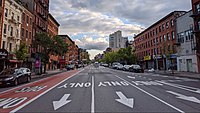Key:change
| Description |
|---|
| Specify the allowed/forbidden lane changes |
| Group: restrictions |
| Used on these elements |
| See also |
| Status: in use |
| Tools for this tag |
|
This key indicates whether there is a lane change restriction preventing a driver or cyclist from changing lanes along the way. Like turn=*, this key is typically used with the :lanes suffix, as well as with the :forward, :backward suffixes on two-way roads. See the proposal for more details.
In the past, some suggested to use the overtaking=* key to indicate the presence of a passing zone or no passing zone, which affects whether a driver can cross over the road's centre line. However, this may be at odds with the explicit provision in Proposed features/change#Examples and Proposed features/change#What about junctions? that appeared later on.
Rationale
Mapping lane change restrictions makes it possible for navigation software to time guidance instructions more precisely, telling drivers when to change lanes without forcing them to cut in line. This key is preferred over mapping the lanes as separate ways, which would violate the rule about only mapping parallel ways when there is a physical separation.
Where to find them
It is common to find a lane change restriction wherever there is a turn lane on a road with multiple lanes. As one approaches an intersection, a turn lane may initially be set off by a dashed line, allowing the driver to enter the turn lane. However, closer to the intersection, the dashed line becomes a solid line. This part of the turn lane, called "storage space" in traffic engineering, prevents drivers from dangerously cutting in line at the last minute. The change=* key allows us to differentiate the storage space of a turn lane.
Lane change restrictions also occur in the absence of a turn lane, such as inside tunnels or around sharp curves where there is poor visibility, or near toll plazas and ferry terminals where lines of vehicles are commonplace.
In some cases, turn lanes may be physically separated from through lanes by a grassy median or concrete barrier. In these cases, map the turn lanes as a separate, parallel way instead of using the change=* key. This allows the median or barrier itself to be mapped and also ensures that routers unaware of the change=* key will not recommend an impossible manoeuvre.
How to map
Set the change=* key to one of the following values. If there are different restrictions depending on the driver's initial lane, set the change:lanes=* key to a list of values separated by vertical bars (|), one value per lane:
| Value | Lane change |
|---|---|
| yes | Allows changing to the left and right adjacent lanes, if present. On the leftmost lane, the value yes is equivalent to not_left; on the rightmost lane, it is equivalent to not_right. |
| no | Does not allow leaving the lane. |
| not_right | Does not allow changing to the right adjacent lane but allows changing to the left adjacent lane. |
| not_left | Does not allow changing to the left adjacent lane but allows changing to the right adjacent lane. |
| Only allows changing to the right adjacent lane, not the left adjacent lane. Equivalent to not_left. Please use not_left instead, which is much more commonly used. | |
| Only allows changing to the left adjacent lane, not the right adjacent lane. Equivalent to not_right. Please use not_right instead, which is much more commonly used. |
It is possible for two adjacent lanes to have an imbalanced lane change restriction, so that it is possible to change from the left lane to the right lane but not the other way around.
Some jurisdictions distinguish between lane changes that are discouraged and those that are illegal. For example, in MUTCD-compliant countries such as the United States, a single solid white line (typical around turn lanes) merely discourages lane changes, whereas a double solid white line (typical around tunnels) prohibits lane changes. There are valid reasons to change lanes where lane changes are discouraged, for example when entering the roadway from an adjacent driveway. In actual usage, this key appears to be used for indications of both discouraged and illegal lane changes.
Turn restriction caused by lane change restriction
If a lane change restriction makes a particular turn impossible (i.e. the turn requires an illegal lane change), then please also create a turn restriction relation. This ensures routers will not recommend an illegal route, even if they are not capable of parsing individual lanes or if they are unable to deduce what lane changes are required and whether they are allowed.
The ![]() way(s) where the required lane change cannot be made will appear in this type=restriction relation with role
way(s) where the required lane change cannot be made will appear in this type=restriction relation with role ![]() via.
via.
